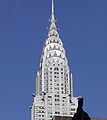Roosevelt Island
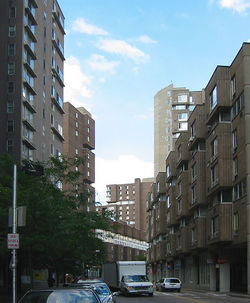 Main Street on Roosevelt Island |
|
 Roosevelt Island (Manhattan)
|
|
| Geography | |
|---|---|
| Location | East River, New York County, New York, USA |
| Area | 0.23 sq mi (0.6 km2) |
| Length | 2 mi (3 km) |
| Width | 0.15 mi (0.24 km) |
| Country | |
|
United States
|
|
| State | |
| City | New York City |
| Borough | Manhattan |
| Demographics | |
| Population | 9,520 (as of 2000) |
| Density | 41,391 /sq mi (15,981.2 /km2) |
| Ethnic groups | 45% white (non-Hispanic), 27% black, 11% Asian or Pacific Islander, and .3% other races |
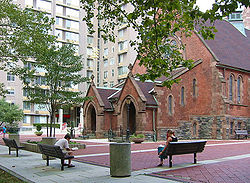
Roosevelt Island, formerly known as Welfare Island (from 1921 to 1973),[1] and before that Blackwell's Island, is a narrow island in the East River of New York City. It lies between the island of Manhattan to its west and the borough of Queens to its east. Running from Manhattan's East 46th to East 85th streets, it is about two miles long, with a maximum width of 800 feet (240 m), and a total area of 147 acres. The island is part of the Borough of Manhattan and New York County. Together with Mill Rock, Roosevelt Island constitutes New York County's Census Tract 238, which has a land area of 0.279 sq mi.[2] and had a population of 9,520 in 2000 according to the US Census.[3] The Roosevelt Island Operating Corporation estimated its population was about 12,000 in 2007.[4] The land is owned by the city, but was leased to the state of New York's Urban Development Corporation for 99 years in 1969. Most of the residential buildings on Roosevelt Island are rental buildings. There is also a cooperative (Rivercross) and a condominium building (Riverwalk Place). One rental building (Eastwood) has left New York State's Mitchell-Lama Housing Program, though current residents are still protected. Three other buildings are now working toward privatization, including the cooperative.
Contents |
History
- 1637 - Dutch Governor Wouter Van Twiller first purchases the island, then known as Hog Island, from the Canarsie Indians[5]
- 1666 - After the English defeat the Dutch, Captain John Manning seizes the island
- 1686 - Manning's son-in-law, Robert Blackwell, becomes the island's new owner and namesake
- 1796 - Blackwell's great-grandson Jacob Blackwell constructs the Blackwell House, the island's oldest landmark, New York City's sixth oldest house and one of the city's few remaining examples of 18th-century architecture
- 1828 - the City of New York purchases the island for $32,000
- A detailed history of the island is posted at http://nyc10044.com/timeln/timeline.html.
Architecture
Though small, Roosevelt Island has a distinguished architectural history. It has several architecturally significant buildings, and has been the site of numerous important unbuilt architectural competitions and proposals.
The island's master plan, adopted by the New York State Urban Development Corporation in 1969, was developed by the firm of Philip Johnson and John Burgee. The plan divided the island into three residential communities, and is noteworthy because it forbade the use of automobiles on the island; the plan intended for residents to park their cars in a large garage and use public transportation to get around. Another innovation was the plan's development of a 'mini-school system,' in which classrooms for the island's public intermediate school were distributed among all the residential buildings in a campus-like fashion (as opposed to being centralized in one large building).
The first phase of Roosevelt Island's development was called "Northtown." It consists of four housing complexes: Westview, Island House, Rivercross, and Eastwood (also known as the WIRE buildings). Rivercross is a Mitchell-Lama co-op, while the rest of the buildings in Northtown are rentals. Eastwood, the largest apartment complex on the island, and Westview were designed by noted architect Josep Lluis Sert, then dean of Harvard Graduate School of Design. Eastwood, along with Peabody Terrace (in Cambridge, Massachusetts), is a prime example of Sert's investigations into high-rise multiple-dwelling residential buildings. It achieves a remarkable level of efficiency by triple-loading corridors with duplex apartment units, such that elevators and public corridors are only needed every three floors. Island House and Rivercross were designed by Johansen & Bhavnani. The two developments were noteworthy for their use of pre-fabricated cladding systems.
Subsequent phases of the island's development have been less innovative, architecturally. Northtown Phase II was developed by the Starrett Corporation and designed by the firm, Gruzen Samton, in a pseudo-historical post-modern style. It was completed in 1989, over a decade after Northtown. Southtown, also designed by Gruzen Samton, is the third phase of the island's development. It was not started until 1998, and is still in the process of development.
As of January 2008, Buildings 1, 2, 3 and 4 have been completed. Buildings 5 and 6 are currently under construction. Residential development of Southtown has brought new retail businesses to Roosevelt Island, including a Starbucks and a Duane Reade. Roosevelt Island, which is known for its limited variety of restaurants, has also gained two new restaurants as a result of Southtown development: Nonno's Foccaceria and Fiji East.
The Octagon, one of the island’s six landmarks, was restored in 2006. Originally designed by Alexander Jackson Davis in 1839 as the New York Lunatic Asylum.[6] The national landmark and LEED Silver green building is now a high-end apartment community. It also houses the largest array of solar panels on any building in New York City.
In addition to Louis Kahn's Franklin D. Roosevelt Four Freedoms Park, the island has also been the site of numerous other architectural speculations. Rem Koolhaas and the Office of Metropolitan Architecture proposed two projects for the Island in his book "Delirious New York": the Welfare Island Hotel and the Roosevelt Island Redevelopment Proposal (both in 1975-76). That proposal was Koolhaas's entry into a competition held for the development of Northtown Phase II. Other entrants included Peter Eisenman, Robert A. M. Stern, and Oswald Mathias Ungers.
In 2006, ENYA (Emerging New York Architects) made the island's abandoned southern end the subject of one of its annual competitions.
Transportation


Although Roosevelt Island is located directly under the Queensboro Bridge, it is not directly accessible from the bridge itself. A trolley used to connect passengers from Queens and Manhattan to a stop in the middle of the bridge, where passengers took an elevator down to the island. The trolley operated from the bridge's opening until April 7, 1957.[7] Between 1930 and 1955, the only vehicular access to the island was provided by an elevator system in the Elevator Storehouse that transported cars and commuters between the bridge and the island. The elevator was closed to the public after the construction of the Roosevelt Island Bridge between the island and Astoria in 1955, and was finally demolished in 1970.
In 1976, the Roosevelt Island Tramway was constructed to provide access to Midtown Manhattan. New York City Subway access via the IND 63rd Street Line finally arrived in 1989. Located over 100 feet below ground level, the Roosevelt Island station is one of the deepest in New York City's subway system.
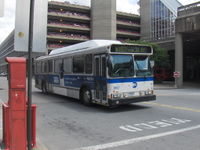
Roosevelt Island's residential community was not designed to support automobile traffic during its planning in the early 1970s. Automobile traffic has become common even though much of the island remains a car-free area. The MTA Bus Company Q102 route operating between the island and Astoria obviates the need for automobiles to some extent.
The Roosevelt Island Operating Corporation (RIOC) operates an on-island shuttle bus service from apartment buildings to the subway and tramway for a fare of 25¢ (10¢ for seniors and disabled people). The bright red buses are highly visible.
Waste on Roosevelt Island is collected by an automated vacuum collection (AVAC) system. This is the only AVAC system serving a residential complex in the USA.
Demographics
As of the 2000 census,[8] Roosevelt Island had a population of 9,520. Fifty-two percent of the population (4,995) were female, and 4,525, or 48%, were male. The population was spread out with 5% under the age of 5, 20% under the age of 18, 67% between the ages of 18 and 65, and 15% over the age of 65.
The racial makeup of the island was 45% white (non-Hispanic), 27% black, 11% Asian or Pacific Islander, and .3% other races. 14% were Hispanics or Latinos of any race.
The median income was $49,976. 37% had an income under $35,000. 40% had incomes between $35,001 and $99,999, and 23% had an income over $100,000.
55% of the total households were family households, and 45% were non-family households. 17% of the residents were married couples with children, and 19% were married couples without children. 36% of the households were one-person households, and 9% were two or more non-family households. 3% were male-based households with related and unrelated children, and 16% were female-based households with related and unrelated children.
In April 2006, The Octagon, a 500-unit luxury rental building, opened its doors. Many young, affluent tenants occupy the studio, one-, two- and three-bedroom units. 100 of the units therein are set aside for middle-income residents. Also in 2006, a multi-building luxury condominium called Riverwalk completed construction of its first buildings.
Government and infrastructure
The United States Postal Service operates the Roosevelt Island Station at 694 Main Street.[9]
Education
Roosevelt Island, as with all parts of New York City, is served by the New York City Department of Education.
Residents are zoned to P.S. 217/I.S. 217 Roosevelt Island School. The Child School and Legacy High School serve K–12 special needs children with learning and emotional disabilities.
Public libraries
New York Public Library operates the Roosevelt Island Branch at 524 Main Street.[10]
Media
The Main Street WIRE
Roosevelt Island has its own community newspaper, The Main Street WIRE, founded in 1979 and published every two weeks. Volunteers deliver the newspaper to every residential door in the community.
The newspaper confines its coverage to Roosevelt Island matters, reporting on community concerns ignored by other New York City media, including issues that arise by virtue of Roosevelt Island being a community within New York City which is operated by the State (not the City) of New York, with a local "authority" called the Roosevelt Island Operating Corporation (RIOC) in charge. For several years, The WIRE has editorialized in favor of a stronger element of elected home rule for the community, and various small steps have been taken in that general direction. Most recently, the Residents Association (RIRA) has been in the process of mounting an election which will serve to nominate members to the Board of Directors of the RIOC. The Governor will retain the final nominating power, however.
The WIRE derives its name from the first four residential buildings constructed on Roosevelt Island: Westview, Island House, Rivercross, and Eastwood. Current and back issues are on line at http://nyc10044.com.
Notable residents and visitors
Prisoners on Blackwell's and Welfare Island
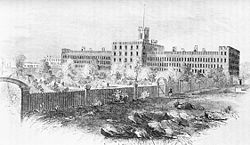
- George Washington Dixon—served six months for libel against Reverend Francis L. Hawks
- Emma Goldman—several times, for activities in support of anarchism and birth control and against the World War I draft
- Peter H. Matthews—for operating policy games (illegal lotteries) all over New York City
- Madame Restell—for performing abortions
- Ida Craddock—convicted for obscenity under the Comstock laws
- Boss Tweed—served one year on corruption-related charges
- Mae West—served eight days on public obscenity charges for her play Sex
- Billie Holiday—served on prostitution charges
- Fritz Joubert Duquesne—Nazi spy and leader of the Duquesne Spy Ring, the largest convicted espionage case in United States history
- Dutch Schultz—arrested for burglary
Visitors who exposed conditions on Blackwell's Island

- Nellie Bly—went undercover as a patient in the Women's Lunatic Asylum and reported what happened in the New York World as well as her book Ten Days in a Mad-House (1887)
- Charles Dickens—described conditions at the "Octagon", an asylum for the mentally ill then located on the northern portion of the island, in his American Notes (1842)
Former residents of Roosevelt Island
.jpg)
- "Grandpa" Al Lewis of The Munsters, now deceased[11][12]
- Comedian Buddy Hackett, now deceased
- Sarah Jessica Parker, Sex and the City
- Comedian Andrea Rosen[13]
- Former United Nations Secretary-General Kofi Annan
Current residents of Roosevelt Island
- Sonia Braga
- Tim Keller, Christian author and minister
- Fez Whatley of The Ron and Fez Show
- Jonah Bobo, actor
- Andrew Donovan
- Jen Frey
- Dres Desmarais
Roosevelt Island in fiction, film and popular entertainment
- 1867: In chapter 13 of Horatio Alger's novel Ragged Dick: Or, Street Life in New York with the Boot Blacks, the character Mickey Maguire, a young tough from Five Points "had acquired an ascendency [sic] among his fellow professionals, and had a gang of subservient followers, whom he led on to acts of ruffianism, not infrequently terminating in a month or two at Blackwell's Island."
- 1893: In the opening chapter of Stephen Crane's novelette "Maggie: A Girl of the Streets", "a worm of yellow convicts" is seen emerging from a prison building on Roosevelt Island.
- 1922: Yank, the main character in Eugene O'Neill's comedy The Hairy Ape, is imprisoned in Blackwell's Island prison, in chapter VI.
- 1925: Roosevelt Island appears in F. Scott Fitzgerald's classic novel The Great Gatsby as Blackwell's Island, in Chapter Four, when Nick and Jay drive into Manhattan via the Queensboro Bridge.
- 1932: A Paramount Pictures film entitled No Man of Her Own is released, a light comedy film starring Clark Gable and Carole Lombard. Upon learning that Gable's character is not in South America, but instead learns he has negotiated a deal to serve 90 days and "he's across the river", Lombard's character then looks out of her hotel window to a view across the East River and the Queensboro Bridge, later refering to this as "Blackwell's Island".
- 1939: A Warner Bros. film entitled Blackwell's Island is released. It stars John Garfield as a crusading reporter investigating corruption in the island's prison.
- 1966: In the film Mister Buddwing, a sign posted on the Williamsburg Bridge in the film reads: "Stairway to Welfare Island." Suzanne Pleshette, playing the character Grace, tries to throw herself off the bridge wearing nothing but a fitted trench coat and white ankle boots, before James Garner's character saves her.
- 1973: In most Pink Floyd Dark Side of the Moon videos Roosevelt Island can be seen during a sequence in the song "Us and Them" with footage taken on top of the Queensboro Bridge.
- 1981: A Roosevelt Island Tramway car is held hostage in the Sylvester Stallone film Nighthawks.
- 1983: The 1983 Italian B movie Fuga dal Bronx has a scene filmed at the north end of the island.
- 1985: In the final scenes of the film Turk 182 the Timothy Hutton character swings above Roosevelt Island on the Queensboro Bridge.
- 1986: The King Kong Tramway ride at Universal Studios opens in Orlando, Florida, featuring the Roosevelt Island Tram.[14]
- 1990: In the first Teenage Mutant Ninja Turtles motion picture, outside shots of the Renwick Ruins are used as the fictitious location for the Foot Clan's secret hideout. A youth clan member informs the police at the end of the film to "check the east warehouses on Lairdman's Island." The name of the island is fictitious - it is a reference to Kevin Eastman and Peter Laird, the creators of the original Teenage Mutant Ninja Turtles series.
- 1991: In the opening scene of City Slickers Billy Crystal's character "Mitch Robbins" is shown commuting to work via the Roosevelt Island tram.
- 1992: In the final level of the video game Atomic Runner for the Sega Mega Drive/Genesis the level takes place on Roosevelt Island Southpoint Park.
- 1993: In the film For Love or Money, Doug Ireland (played by Michael J. Fox) wants to buy the "abandoned hotel" at the south end of Roosevelt Island, referring to the ruins of the Smallpox Hospital.
- 1994: In The Professional Mathilda Lando (played by Natalie Portman) takes the Tramway to Roosevelt Island to seek asylum at the Spenser School.
- 1997: The film Conspiracy Theory was shot on location in and around New York City. Sites included Times Square, Union Square, Greenwich Village, the Queensboro Bridge, Roosevelt Island, and the Westchester Medical Center in Valhalla, New York.
- 2001: Roosevelt Island's ruins, particularly the Smallpox Hospital and the Strecker Memorial Laboratory, play a central role in Linda Fairstein's police procedural novel The Dead House (Scribner 2001).
- 2002: Near the end of the film Spider-Man, the Green Goblin blows up the Roosevelt Island side tram station and leaves a group of children hanging inside one car. He also brings Spider-Man down to fight with him in the abandoned Smallpox Hospital on the island. The tram and the island make other appearances in Spider-Man media. The island is featured in the video game Spider-Man 2. In The Amazing Spider-Man #161 and #162, appearing on the cover of the latter,[15] and Spider-Man and Hulk fight on Roosevelt Island in The Amazing Spider-Man #328.
- 2002: In the film Gangs of New York, Leonardo Di Caprio's character Amsterdam Vallon is seen leaving "Hellgate House of Reform, Blackwell's Island, New York City".
- 2003: In the film Anything Else, Woody Allen's character, David Dobel, is a schoolteacher who lives on the island.
- 2004: A significant scene in Caitlin R. Kiernan's story "Riding The White Bull" takes place on Roosevelt Island.
- 2005: Roosevelt Island is the setting for Brazilian director Walter Salles movie Dark Water, where Dahlia (Jennifer Connelly) moves into a low-rent apartment with her daughter and then is terrorized by the ghost of a girl that used to live upstairs.
- 2005: In the second season episode of CSI: New York called "Dancing with the Fishes", a crime is committed inside the Roosevelt Island tram.
- 2005: In the famous novel by Caroline B. Cooney, Code Orange's main character, Mitty, is studying smallpox for his own survival. He goes and visits the Smallpox Hospital ruins on Roosevelt Island.
- 2006: The fictional high school which the main characters attend in the GONZO anime series Red Garden is on Roosevelt Island.
- 2007: In the film The Brave One, starring Jodie Foster, a memorable scene takes place at the Roosevelt Island parking lot. The film mentions the island several times.
- 2007: In the novel by Cassandra Clare, City of Bones, the protagonist is drawn to the island for a showdown with the elusive villain, Valentine.
- 2008: In the video game Grand Theft Auto IV there is an island resembling Roosevelt Island, named Colony Island. It also includes the ruins of a hospital, similar to the Smallpox Hospital.
- 2009: On May 23, the island was the site of Improv Everywhere's "MP3 Experiment Six". Approximately 4,500 people traveled to the island to take part in a performance art piece where the southernmost point of the island became a "battleground" for the re-enactment of a fictional melee between townspeople and an ancient wolf.
- 2010: On the TV show "24," NY CTU appears to be based out of Roosevelt Island (at least its helipad does).
See also
- Theodore Roosevelt Island, Washington, D.C.
- United States Presidential Memorial
Notes
- ↑ Timeline of Island History, NYC10044 website, accessed March 2, 2009
- ↑ [1] United States Census Bureau
- ↑ Hughes, C.J. (September 2, 2007). "An Island Joins the Mainstream". The New York Times. http://www.nytimes.com/2007/09/02/realestate/02livi.html. Retrieved May 22, 2010.
- ↑ According to the US Census 2000, Mill Rock Island (Census Block 9000) is unpopulated
- ↑ An Overview of Roosevelt Island
- ↑ Brockmann, Jorg et al. (2002). One Thousand New York Buildings, p. 268. at Google Books
- ↑ McCandlish, Phillips (April 7, 1957). "City's Last Trolley at End of Line; Buses Will Replace 49-Year Route on Queensboro Span". The New York Times: p. 1. http://select.nytimes.com/gst/abstract.html?res=F10C15FF345A137A93C5A9178FD85F438585F9. Retrieved August 17, 2008.
- ↑ rioc.com
- ↑ "Post Office Location - Roosevelt Island." United States Postal Service. Retrieved on January 30, 2009.
- ↑ "Roosevelt Island Branch." New York Public Library. Retrieved on December 22, 2008.
- ↑ [2]
- ↑ [3]
- ↑ Eliot Glazer (2007-10-11). "Inside With: Andrea Rosen". The Apiary. http://www.theapiary.org/archives/2007/10/inside_with_and_1.html.
- ↑ "King Kong: The Monster Who Created Universal Studios Florida", Peter Alexander, Totally Fun Company.
- ↑ Comics:Amazing Spider-Man Vol 1 162, Marvel Database Project.
References
- Brockmann, Jorg and Bill Harris. (2002). One Thousand New York Buildings. New York: Black Dog & Leventhal. 10-ISBN 157912237X/13-ISBN 9781579122379; OCLC 48619292
|
|||||||||||
|
|||||||
